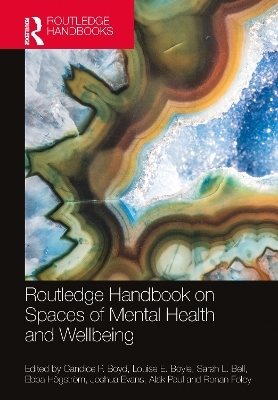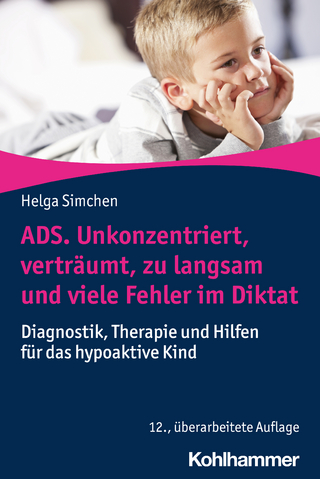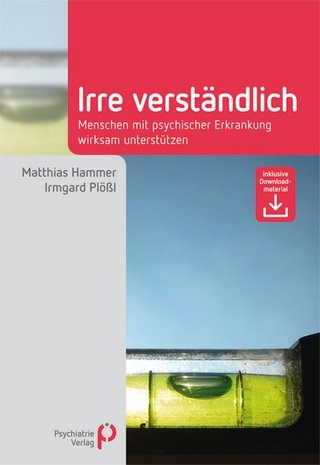
Routledge Handbook on Spaces of Mental Health and Wellbeing
Routledge (Verlag)
978-1-032-38576-1 (ISBN)
- Noch nicht erschienen (ca. November 2024)
- Versandkostenfrei innerhalb Deutschlands
- Auch auf Rechnung
- Verfügbarkeit in der Filiale vor Ort prüfen
- Artikel merken
The Routledge Handbook on Spaces of Mental Health features 44 chapters from leading international scholars who collectively interrogate the spatial dimensions of mental health and wellbeing from conceptual and experiential viewpoints. The ways in which these theoretical developments prompt a re-thinking of mental health and wellbeing as concepts is also discussed before presenting some highlights from the handbook’s 5 main sections – (1) green and blue spaces, (2) lived and embodied spaces, (3) creative spaces, (4) work and home spaces, and (5) institutional and post-institutional spaces. The key benefits of this book include a great appreciation of the complex networks and assemblages of mental health and wellbeing, the value of a geographical/spatial approach to thinking about mental health, and the vast array of spaces and places that are implicated in human and posthuman notions of wellbeing.
This book will be of interest to students and scholars across the social sciences and the humanities as well as researchers and practitioners in the fields of psychology, psychiatry, social work, nursing, health geography, social and cultural geography, anthropology, mental health social studies, cultural, theory, and architecture.
Candice P. Boyd is an artist-geographer and clinical psychologist. They are currently an honorary Principal Fellow in the School of Geography, Earth and Atmospheric Sciences at the University of Melbourne researching spaces of mental health and well-being, arts-based knowledge translation, and climate-related mental health issues. They are author of Exhibiting Creative Geographies (2023) and Non-Representational Geographies of Therapeutic Art Making (2017), co-author of Emotion and the Contemporary Museum (2020), and co-editor of Non-Representational Theory and the Creative Arts (2019). Louise E. Boyle is a health geographer and Honorary Research Fellow in the School of Geographical and Earth Sciences at the University of Glasgow, Scotland. She completed an ESRC-funded PhD on The Social and Anticipatory Geographies of Social Anxiety Disorder (2019) and built on this research through an ESRC Post-Doctoral Research Fellowship (2020-2022). She is the author of Anxious Geographies: Worlds of Social Anxiety (Routledge, 2024). Sarah L. Bell is a health geographer at the University of Exeter, whose work examines experiences of mental health, wellbeing, disability and social inclusion in and with diverse forms of ‘nature’ - from parks, gardens, woodlands, coast and countryside to the weather, seasons and climate change (www.sensing-nature.com). Most recently, Sarah has been developing new collaborations to understand how the climate crisis – and prominent societal responses to it – is shaping the everyday lives and adaptive capacities of people with varied experiences and histories of disability (www.sensing-climate.com). Ebba Högström is Professor in Architecture at Umeå University. Her research interest is in social and experiential dimensions of architecture and the built environment. A specific interest is in geographies of welfare institutions and infrastructures of care. Currently, she is engaged in research projects addressing housing and living environments for vulnerable groups, i.e., people with mental ill-health and older people. Together with C Nord, she has-edited the book Caring Architecture: Institutions and Relational Practices (2017). Joshua Evans is associate professor of human geography at the University of Alberta. He is a social geographer with interests in spaces of care, home, and work and their role in shaping the lived experiences of socially marginalized and vulnerable individuals, as well as spaces of policy development and implementation and their role in the creation of healthy, enabling and equitable urban environments. His most recent research focuses on housing, homelessness and urban justice. Alak Paul is a health geographer at the University of Chittagong, Bangladesh. His research interest covers stigmatized diseases and public health. He focuses on everyday geographies of marginalized or vulnerable people in his research, especially how geographic space or place plays a role in reshaping the life of people or the environment. He is the author of HIV/AIDS in Bangladesh: Stigmatized People, Policy and Place (2020) and co-editor of Geography in Bangladesh: Concepts Methods and Applications (Routledge, 2019) and The Palgrave Handbook of Social Fieldwork (2023). Ronan Foley is an Associate Professor in Health Geography and GIS at Maynooth University, Ireland, with expertise in therapeutic landscapes and geospatial planning within health and social care environments. His research focuses on relationships between water, health and place, including two books and journal articles on holy wells, spas, social and cultural histories of swimming and ‘blue space’. He is an Editorial Board member of Health & Place, was Editor of Irish Geography, 2015-2022 and chairs the MU Healthy Campus Steering Group. He collaborates on water/health projects with colleagues in Ireland, UK, Spain, Germany, New Zealand and Australia.
1 Introducing the Routledge Handbook on Spaces of Mental Health and Well-Being
SECTION 1
2 Introducing Green and Blue Spaces
Part A: Implications for Mental Health
3 Greenspace programmes for mental health
Wendy Masterton
4 Ten big picture actions for mainstreaming gardening into public health
Jonathan (Yotti) Kingsley
5 What is the Right Dose of Nature for Mental Health? Quantity, Quality, Distance, and Exposure Time
Marco Garrido-Cumbrera
6 Nature contact and burnout
Thomas Astell-Burt, Michael Navakatikyan and Xiaoqi Feng
7 Biodiversity for Health and Wellbeing
Jessica Fisher, Gail E. Austen, Martin Dallimer, Katherine N. Irvine and Zoe Davies
8 The affective quality of blue spaces – The Case Study of a Wetland in Wakiso District, Uganda
Sophie-Bo Heinkel and Thomas Kistemann
Green and Blue Spaces
Part B: Critical Perspectives
9: Untangling nature-based Interventions’ influences on participants’ mental wellbeing: Critiquing 'nature on prescription'.
Andy Harrod and Nadia von Benzon
10 Seeking asylum, ‘therapeutic landscapes’, agency and lived citizenship.
Josephine Biglin
11 Green gentrification and its impacts on mental health: unveiling the evidence on sociocultural and physical exclusion linked to green and blue spaces
Margarita Triguero-Mas and Helen V.S. Cole
12 How do we understand the impact of immersion in blue space on mental health and wellbeing?
Hannah Denton, Kay Aranda and Charlie Dannreuther
13 Lifestyle sports, social justice, blue space and mental health inequalities
Belinda Wheaton and Rebecca Olive
14 Intoxicated: Men, Mental Health, Wellbeing, and Pollution in Blue Spaces
Clifton Evers
SECTION 2
15 Introducing Lived and Embodied Spaces
16 Feeling SAD: embodied geographies of seasonal affective disorder
Shawn Bodden, Hayden Lorimer and Hester Parr
17 Geographies of Panic: Towards a relational conceptualisation of panic ‘disorder’
Candela Sánchez-Rodilla Espeso
18 Taking up space: anorexia nervosa and embodied healing
Grace Lucas
19 Dance Movement Psychotherapy in acute adult psychiatry: space, time and affective atmospheres in the ward landscape
Mary Coaten
20 Embodiment and space in understandings of suicide and self-harm
Amy Chandler, Sarah Huque, Rebecca, Helman, Joe Anderson and Emily Yue
21 The university as a lived space: The experience of students in distress
Emma Farrell and Sheena Hyland
SECTION 3
22 Introducing Creative Spaces
23 Spaces of Australian Indigenous Song and Dance
Paul Callaghan and Jesse Hodgetts
24 Caring through circulation: reflections on affect and materiality at the second-hand book market of College Street, Calcutta
Diti Bhattacharya
25 BAJO EL OLIVO (Under the Olive Tree): Experimenting with A Posthuman Life and Landscape with Radical Affection in an Artist Residency
Juliana España Keller
26 Distributed Assemblages of Cognition and Health (Or) How TikTok ate my Mind
Jamie McPhie and David A. G. Clarke
27 Distance and Belonging in the Studio
Christian Edwardes
28 Creative Spaces of Disaster Recovery
Kate E. W. Douglas
29 Regional arts festivals as infrastructures of care
Michelle Duffy, Judith Mair and Elaine Stratford
SECTION 4
30 Introducing Work and Home Spaces
31 Recovering Place and Wellbeing for Individuals with Mental Illness
Nastaran Doroud and Ellie Fossey
32: Permanent Supportive Housing: A Key Role in Serving the Needs of Unhoused Individuals
Deborah K. Padgett
33 Exploring the complex negotiation of home, aging, and mental health: Haven or not?
Rachel Herron
34 Haven or Hell?: An introduction to trauma informed design as a mechanism for place-based healing
Julia Woodhall-Melnik, Cassandra Monette, and Erin MacKenney
35 Breadwinning, Mental Health and the Geographies of Masculinity
Robert Wilton and Ann Fudge Schormans
36 Creating space for youth mental health online: A clinician’s perspective
Candice P. Boyd
37 Landscapes of trauma and mental health
Jesse Proudfoot
SECTION 5
38 Introducing Institutional and Post-Institutional Spaces
39 ‘Healing Architecture’ and the Spatial Organization of the Psychiatric Clinic
Thorben Peter Høj Simonsen
40 Islands as Spaces of Institutionalised Mental Health and Wellbeing
Robin Kearns and John Connell
41 The New Institutional Landscape for People with Mental Health Problems
Alain Topor, Tore Dag Bøe, Oyvind Hope, Ottar Ness and Jan Friesinger
42 A New Space for ‘Curing Madness’: Circulation of an Open-Door model between France and Argentina in the early 20th century
Hervé Guillemain and Fernando Ferrari
43 Carceral Riskscapes in the Institutions of Care
Virve Repo
44 Writing the Asylum: Archive and Creativity in the Abandoned Space
Gillean McDougall
45 Mental health geography in the cracks: between abolition and reform
Ebba Högström and Chris Philo
| Erscheint lt. Verlag | 12.11.2024 |
|---|---|
| Zusatzinfo | 15 Tables, black and white; 8 Line drawings, black and white; 39 Halftones, black and white; 47 Illustrations, black and white |
| Verlagsort | London |
| Sprache | englisch |
| Maße | 174 x 246 mm |
| Gewicht | 453 g |
| Themenwelt | Medizin / Pharmazie ► Medizinische Fachgebiete ► Psychiatrie / Psychotherapie |
| Sozialwissenschaften ► Soziologie ► Spezielle Soziologien | |
| Technik ► Umwelttechnik / Biotechnologie | |
| ISBN-10 | 1-032-38576-6 / 1032385766 |
| ISBN-13 | 978-1-032-38576-1 / 9781032385761 |
| Zustand | Neuware |
| Haben Sie eine Frage zum Produkt? |
aus dem Bereich


